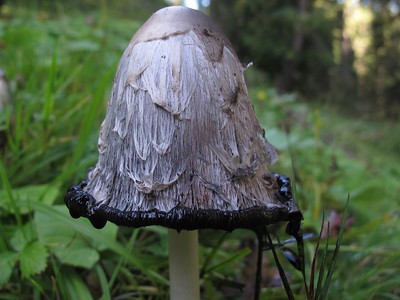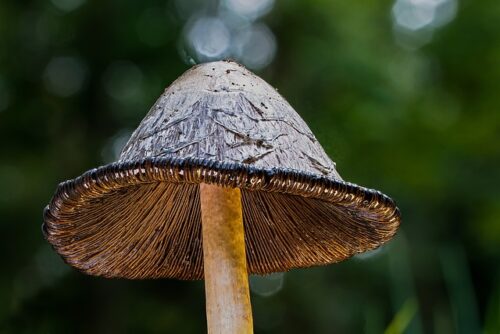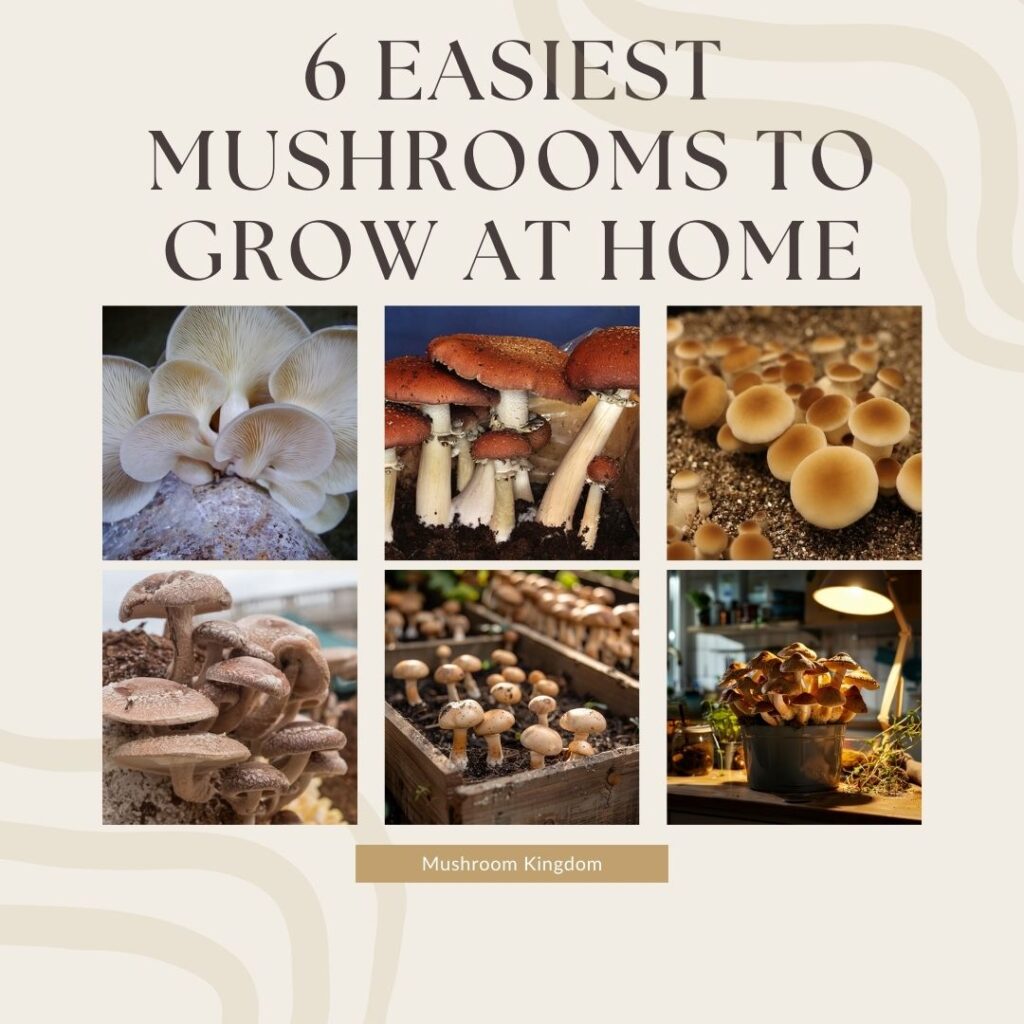Shaggy Mane (Coprinus comatus) is a distinctive edible mushroom known for its shaggy, white cap covered with upturned scales that turns inky black as it matures.
It typically grows in lawns, gardens, and disturbed grounds, especially after rain.

How To Identify Shaggy Mane Mushroom?
Identifying a Shaggy Mane mushroom (Coprinus comatus) involves recognizing several key features. Here’s a detailed guide to help you:

The cap
When young, it has a cylindrical or egg-shaped cap that becomes bell-shaped as it matures. The cap surface is shaggy, with white to brownish scales or fibers, giving it a fringed appearance. Initially white, the cap can develop brownish scales as it ages. Typically, the cap ranges from 2 to 6 inches (5 to 15 cm) tall and about 1 to 2 inches (2.5 to 5 cm) wide.
The gills
They start off white, turn pink, and eventually become black as the mushroom ages. The gills are free from the stem and are delicate and crowded.

The Stem
Moving to the stem, you’ll find it is 4 to 8 inches (10 to 20 cm) long and around 0.5 to 1 inch (1.3 to 2.5 cm) thick.
The stem is white, smooth, and hollow. A notable feature is the presence of a movable ring around the upper part of the stem.
For further confirmation, take a spore print. Place the cap gill-side down on a white piece of paper for several hours or overnight. The spore print of a Shaggy Mane will be black.
Habitat
You can often find Shaggy Mane mushrooms in lawns, gardens, along roadsides, and in disturbed grounds. They typically appear from spring to autumn, especially after rain.
Distinguishing Features
The Shaggy Mane mushroom is unique with its delicate, shaggy cap.
As it matures, it undergoes autodigestion, where the gills and cap turn into a black, inky liquid, giving rise to its other name, “Inky Cap.” The smooth, hollow stem with a movable ring also helps in identification.
Caution
While Shaggy Mane mushrooms are edible when young (before the gills turn black), ensure accurate identification before consumption.
Some inky caps can cause gastrointestinal distress, especially if consumed with alcohol. Be aware of other Coprinus species or similar-looking mushrooms that might not be safe to eat.
If in doubt, consult a local mycologist or mushroom expert.
Is Shaggy Mane Mushroom Edible?
Shaggy Mane mushrooms are edible and can be a delicious addition to your meals when harvested at the right time.
Shaggy Mane mushrooms are best eaten when they are young, with caps that are still white and firm. As they mature, the gills turn black and the cap starts to dissolve into an inky liquid, making them less desirable for eating.
Ensure you harvest them before the autodigestion process (deliquescence) begins. This process turns the mushroom into a black, inky substance, hence the alternative name “Inky Cap.”
Gently clean the mushrooms with a damp cloth or brush to remove any dirt or debris. Avoid soaking them in water, as they can absorb it and become soggy.
Caution When Cooking Shaggy Mane
While Shaggy Mane mushrooms themselves do not cause adverse reactions with alcohol, some related species (such as Coprinus atramentarius, the “Common Ink Cap”) can cause a reaction known as the “Coprine syndrome” when consumed with alcohol.
To be safe, avoid consuming alcohol for at least 24 hours before and after eating Shaggy Mane mushrooms.
Also, eat them soon after harvesting, as they do not store well and can deteriorate quickly.
How To Cook Shaggy Mane Mushrooms
Cooking is straightforward and can yield delicious results.
Pick Shaggy Mane mushrooms when they are young and white before the gills turn black and the cap starts to dissolve.
Next, gently clean the mushrooms with a damp cloth or a soft brush to remove any dirt. Avoid soaking them in water, as they can absorb it and become soggy.
From there, you can choose to grill them, saute them, or put them into your favourite soup or salad. Here is my favorite method:
Sautéing
- Ingredients:
- Fresh Shaggy Mane mushrooms
- Butter or olive oil
- Garlic (optional)
- Salt and pepper
- Fresh herbs (such as parsley or thyme, optional)
Steps:
- Heat a pan over medium heat and add butter or olive oil.
- Add minced garlic to the pan (if using) and sauté until fragrant, about 1 minute.
- Add the cleaned Shaggy Mane mushrooms to the pan.
- Cook, stirring occasionally, until the mushrooms release their moisture and start to brown, about 5–7 minutes.
- Season with salt, pepper, and fresh herbs to taste.
Are Shaggy Mane Mushrooms Poisonous To Dogs?
While Shaggy Manes are not inherently toxic, they could cause mild gastrointestinal upset in some dogs, as with many non-toxic mushrooms. Symptoms might include vomiting or diarrhea.
Dogs, like humans, can have individual sensitivities or allergies. Even safe mushrooms might cause adverse reactions in certain pets.
How to Preserve Shaggy Mane Mushroom?
Preserving Shaggy Mane can be challenging due to their tendency to autodigest quickly. The two best methods are to freeze them or dry them.
Freezing
Gently clean the mushrooms with a damp cloth or soft brush to remove dirt and debris.
Bring a pot of water to a boil. Add the cleaned mushrooms and blanch them for 2–3 minutes. Then, immediately transfer the mushrooms to an ice water bath to stop the cooking process.
Drying
Clean the mushrooms and slice them thinly to facilitate drying. Arrange the mushroom slices in a single layer on the trays of a food dehydrator.
Then, dry at a low temperature (around 110°F or 43°C) until they are completely dry and brittle.
Or, preheat the oven to the lowest possible temperature. Arrange the mushroom slices on a baking sheet lined with parchment paper. Place the baking sheet in the oven with the door slightly ajar to allow moisture to escape.
Dry until the mushrooms are brittle.
Shaggy Mane Look-Alikes To Be Aware Of
There are a few look-alikes that foragers should be aware of. While some of these look-alikes are harmless, others can cause adverse reactions or are not suitable for consumption. Here are some notable look-alikes:
1. Common Ink Cap (Coprinopsis atramentaria)
- Appearance: Similar in its initial white or grayish cap that turns inky black as it matures. However, it lacks the shaggy scales seen on Shaggy Manes.
- Key Difference: The Common Ink Cap has a smoother cap and tends to grow in clusters.
- Edibility: Edible, but causes a toxic reaction if consumed with alcohol (Coprine syndrome).
2. Glistening Ink Cap (Coprinellus micaceus)
- Appearance: Smaller and often found in large clusters on decaying wood. The cap is brownish and covered with mica-like granules when young.
- Key Difference: Smaller size, browner color, and presence of granules on the cap.
- Edibility: Edible but not considered choice due to its small size and rapid deliquescence.
3. Coprinopsis variegata (formerly Coprinus quadrifidus)
- Appearance: Similar in appearance with a shaggy, scaly cap but tends to be more yellowish or brown.
- Key Difference: The cap is more consistently yellow-brown and found in forested areas rather than open lawns.
- Edibility: Edible when young but not commonly consumed.
Shaggy Manne Interesting Facts
Shaggy Mane mushrooms undergo a process called autodigestion or deliquescence, where the gills and cap dissolve into a black, inky liquid as they mature. This helps disperse their spores.
Historically, the ink produced by deliquescent Shaggy Manes was used for writing, as it provided a natural source of ink. In some cultures, it was also associated with good luck and are thought to indicate fertile land or an abundant harvest.


